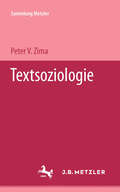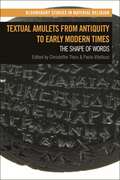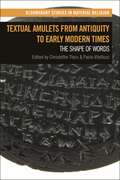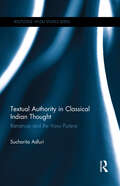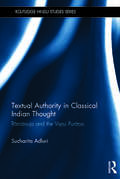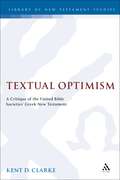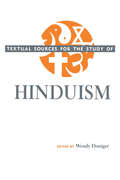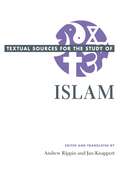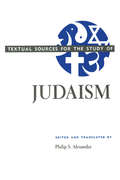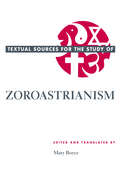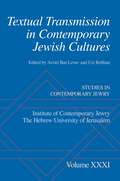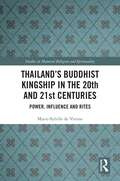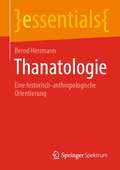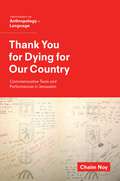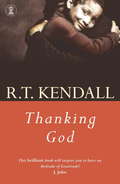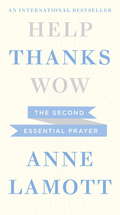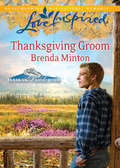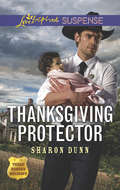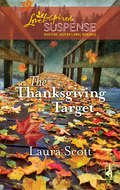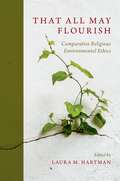- Table View
- List View
Textual Amulets from Antiquity to Early Modern Times: The Shape of Words (Bloomsbury Studies in Material Religion)
by Christoffer Theis and Paolo VitellozziComparing amulets over time and space, this volume focuses on the function of written words on these fascinating artefacts. Ranging from Roman Egypt to the Middle Ages and the Modern period, this book provides an overview on these artefacts in the Mediterranean world and beyond, including Europe, Iran, and Turkey. A deep analysis of the textuality of amulets provides comparative information on themes and structures of the religious traditions examined. A strong emphasis is placed on the material features of the amulets and their connections to ritual purposes. The textual content, as well as other characteristics, is examined systematically, in order to establish patterns of influence and diffusion. The question of production, which includes the relationships that linked professional magicians, artists and craftsmen to their clientele, is also discussed, as well as the sacred and cultural economies involved.
Textual Amulets from Antiquity to Early Modern Times: The Shape of Words (Bloomsbury Studies in Material Religion)
Comparing amulets over time and space, this volume focuses on the function of written words on these fascinating artefacts. Ranging from Roman Egypt to the Middle Ages and the Modern period, this book provides an overview on these artefacts in the Mediterranean world and beyond, including Europe, Iran, and Turkey. A deep analysis of the textuality of amulets provides comparative information on themes and structures of the religious traditions examined. A strong emphasis is placed on the material features of the amulets and their connections to ritual purposes. The textual content, as well as other characteristics, is examined systematically, in order to establish patterns of influence and diffusion. The question of production, which includes the relationships that linked professional magicians, artists and craftsmen to their clientele, is also discussed, as well as the sacred and cultural economies involved.
Textual Authority in Classical Indian Thought: Ramanuja and the Vishnu Purana (Routledge Hindu Studies Series)
by Sucharita AdluriTheistic Vedānta originated with Rāmānuja (1077-1157), who was one of the foremost theologians of Viśistādvaita Vedānta and also an initiate of the Śrīvaisnava sectarian tradition in South India. As devotees of the God Visnu and his consort Śrī, the Śrīvaisnavas established themselves through various processes of legitimation as a powerful sectarian tradition. One of the processes by which the authority of the Śrīvaisnavas was consolidated was Rāmānuja’s synthesis of popular Hindu devotionalism with the philosophy of Vedānta. This book demonstrates that by incorporating a text often thought to be of secondary importance - the Visnu Purāna (1st-4th CE) - into his reading of the Upanisads, which were the standard of orthodoxy for Vedānta philosophy, Rāmānuja was able to interpret Vedānta within the theistic context of Śrīvaisnavism. Rāmānuja was the first Brahmin thinker to incorporate devotional purānas into Vedānta philosophy. His synthetic theology called Viśistādvaita (unity-of-the-differenced) wielded tremendous influence over the expansion of Visnu devotionalism in South India and beyond. In this book, the exploration of the exegetical function of this purana in arguments salient to Rāmānuja’s Vedānta facilitates our understanding of the processes of textual accommodation and reformulation that allow the incorporation of divergent doctrinal claims. Expanding on and reassessing current views on Rāmānuja’s theology, the book contributes new insights to broader issues in religious studies such as canon expansion, commentarial interpretation, tradition-building, and the comparative study of scripture. It will be of interest to students and scholars of Indian philosophy and Religious Studies.
Textual Authority in Classical Indian Thought: Ramanuja and the Vishnu Purana (Routledge Hindu Studies Series)
by Sucharita AdluriTheistic Vedānta originated with Rāmānuja (1077-1157), who was one of the foremost theologians of Viśistādvaita Vedānta and also an initiate of the Śrīvaisnava sectarian tradition in South India. As devotees of the God Visnu and his consort Śrī, the Śrīvaisnavas established themselves through various processes of legitimation as a powerful sectarian tradition. One of the processes by which the authority of the Śrīvaisnavas was consolidated was Rāmānuja’s synthesis of popular Hindu devotionalism with the philosophy of Vedānta. This book demonstrates that by incorporating a text often thought to be of secondary importance - the Visnu Purāna (1st-4th CE) - into his reading of the Upanisads, which were the standard of orthodoxy for Vedānta philosophy, Rāmānuja was able to interpret Vedānta within the theistic context of Śrīvaisnavism. Rāmānuja was the first Brahmin thinker to incorporate devotional purānas into Vedānta philosophy. His synthetic theology called Viśistādvaita (unity-of-the-differenced) wielded tremendous influence over the expansion of Visnu devotionalism in South India and beyond. In this book, the exploration of the exegetical function of this purana in arguments salient to Rāmānuja’s Vedānta facilitates our understanding of the processes of textual accommodation and reformulation that allow the incorporation of divergent doctrinal claims. Expanding on and reassessing current views on Rāmānuja’s theology, the book contributes new insights to broader issues in religious studies such as canon expansion, commentarial interpretation, tradition-building, and the comparative study of scripture. It will be of interest to students and scholars of Indian philosophy and Religious Studies.
Textual Optimism: A Critique of the United Bible Societies' Greek New Testament (The Library of New Testament Studies #138)
by Kent ClarkeClarke offers an important study of the standard text of the New Testament that is in the hands of every new Testament scholar. He compares the five editions to appear since 1966, focusing upon the textual apparatus and the A, B, C and D evaluation of evidence letter-ratings. Clarke presents the evidence of extensive 'grade inflation' in the fourth edition, implying a much higher degree of certainty than previous editions had accepted. He claims that the editors have not only been inconsistent and overly optimistic in their modifications, but have also failed to provide readers with an adequate explanation and methodological basis for these unprecedented changes.
Textual Sources for the Study of Hinduism (Textual Sources for the Study of Religion)
by Wendy Doniger O'Flaherty Daniel H. Gold David Shulman"A wider range than usual of Sanskrit texts: not only interesting Vedic, epic, and mythological texts but also a good sampling of ritual and ethical texts. . . . There are also extracts from texts usually neglected, such as medical treatises, works on practical politics, and guides to love and marriage. . . . Readings from the vernacular Hindi, Bengali, and Tamil traditions [serve to] enrich the collection and demonstrate how Hinduism flourished not just in Sanskrit but also in its many mother tongues."—Francis X. Clooney, Journal of Asian Studies
Textual Sources for the Study of Islam (Textual Sources for the Study of Religion)
by Andrew Rippin Jan Knappert"[This collection] is distinguished by its wide range and the care which has clearly gone into the selection of texts for inclusion. . . . Attention has understandably been focused on what might be called the religious aspects of Islam, such as scripture, theology, sects, law, ritual and mysticism, but within those limits the texts chosen are marked by substantially of content, by geographical, chronological and social diversity, and by an intelligent use of less well known authors. . . . An excellent starting point for a systematic and analytical examination of Islam."—G. R. Hawting, Bulletin of the School of Oriental and African Studies
Textual Sources for the Study of Judaism (Textual Sources for the Study of Religion)
by Philip S. Alexander"Alexander assembles material from Scripture and tradition, through religious law and ethical literature to a section on Society and the Jews, and prefaces the whole with an admirable introduction."—Jonathan Sacks, Jewish Chronicle "The texts . . . which are drawn from over two thousand years of history, are usefully divided, annotated and glossed. They enable students to explore the tradition in a new way [and] give a marvellous insight into the richness and liveliness of the Jewish religion and culture: we are given wit and pathos in addition to popular story and religious law."—Janet Trotter, Resource
Textual Sources for the Study of Zoroastrianism (Textual Sources for the Study of Religion)
by Mary Boyce"Boyce is a, perhaps the, world authority on Zoroastrianism. . . . Prefaced by a 27-page introduction, this anthology contains selections which offer a complete picture of Zoroastrian belief, worship and practice. There are historical texts from the sixth century B.C. onwards, and extracts from modern Zoroastrian writings representing traditionalism, occultism and reformist opinion. Anyone wishing to know more about this 'least well known of the world religions' should sample these selections."—The Methodist Church "Wide-ranging. . . . An indispensable one-volume collection of primary materials."—William R. Darrow, Religious Studies Review
Textual Transmission in Contemporary Jewish Cultures (Studies in Contemporary Jewry)
by Avriel Bar-Levav, Uzi RebhunJewish culture places a great deal of emphasis on texts and their means of transmission. At various points in Jewish history, the primary mode of transmission has changed in response to political, geographical, technological, and cultural shifts. Contemporary textual transmission in Jewish culture has been influenced by secularization, the return to Hebrew and the emergence of modern Yiddish, and the new centers of Jewish life in the United States and in Israel, as well as by advancements in print technology and the invention of the Internet. Volume XXXI of Studies in Contemporary Jewry deals with various aspects of textual transmission in Jewish culture in the last two centuries. Essays in this volume examine old and new kinds of media and their meanings; new modes of transmission in fields such as Jewish music; and the struggle to continue transmitting texts under difficult political circumstances. Two essays analyze textual transmission in the works of giants of modern Jewish literature: S.Y. Agnon, in Hebrew, and Isaac Bashevis Singer, in Yiddish. Other essays discuss paratexts in the East, print cultures in the West, and the organization of knowledge in libraries and encyclopedias.
Textual Transmission in Contemporary Jewish Cultures (Studies in Contemporary Jewry)
Jewish culture places a great deal of emphasis on texts and their means of transmission. At various points in Jewish history, the primary mode of transmission has changed in response to political, geographical, technological, and cultural shifts. Contemporary textual transmission in Jewish culture has been influenced by secularization, the return to Hebrew and the emergence of modern Yiddish, and the new centers of Jewish life in the United States and in Israel, as well as by advancements in print technology and the invention of the Internet. Volume XXXI of Studies in Contemporary Jewry deals with various aspects of textual transmission in Jewish culture in the last two centuries. Essays in this volume examine old and new kinds of media and their meanings; new modes of transmission in fields such as Jewish music; and the struggle to continue transmitting texts under difficult political circumstances. Two essays analyze textual transmission in the works of giants of modern Jewish literature: S.Y. Agnon, in Hebrew, and Isaac Bashevis Singer, in Yiddish. Other essays discuss paratexts in the East, print cultures in the West, and the organization of knowledge in libraries and encyclopedias.
Thailand’s Buddhist Kingship in the 20th and 21st Centuries: Power, Influence and Rites (Studies in Material Religion and Spirituality)
by Marie-Sybille de VienneBased on two decades of fieldwork, including over a hundred interviews with various political and economic actors at different social levels, as well as documentary and media analysis, this volume presents an account of the Buddhist monarchy in Thailand, offering a sociology of elites, an analysis of the economic influence of the Crown and an examination of the magic and ritual dimension of kingship. An exploration of the role and status of the Palace over the last century, whether as a guarantor of democracy, a symbol of stability, a source of power or an object of popular discontent, Thailand’s Buddhist Kingship in the 20th and 21st Centuries will appeal to scholars of sociology and anthropology with interests in material religion, politics and Southeast Asian studies.
Thailand’s Buddhist Kingship in the 20th and 21st Centuries: Power, Influence and Rites (Studies in Material Religion and Spirituality)
by Marie-Sybille de VienneBased on two decades of fieldwork, including over a hundred interviews with various political and economic actors at different social levels, as well as documentary and media analysis, this volume presents an account of the Buddhist monarchy in Thailand, offering a sociology of elites, an analysis of the economic influence of the Crown and an examination of the magic and ritual dimension of kingship. An exploration of the role and status of the Palace over the last century, whether as a guarantor of democracy, a symbol of stability, a source of power or an object of popular discontent, Thailand’s Buddhist Kingship in the 20th and 21st Centuries will appeal to scholars of sociology and anthropology with interests in material religion, politics and Southeast Asian studies.
Thanatologie: Eine historisch-anthropologische Orientierung (essentials)
by Bernd HerrmannBestattungsritual und Behandlung der Toten sind elementare Merkmale einer Kultur. Eine Gesellschaft gibt sich im Bestattungsritual, in der Behandlung der Toten und in den Vor- wie Nachbereitungen der Beisetzung über die soziale Identität des Verstorbenen und über den Zusammenhalt der Gemeinschaft Rechenschaft. In der Thanatologie werden mit den Mitteln von Archäologie und Prähistorischer Anthropologie die praxeologischen Zeichen rekonstruiert, soweit sie materielle Spuren im Quellenmaterial und in dessen Umfeld hinterlassen haben. Dargestellt sind die gängigen Überlieferungsformen von menschlichen Überresten und mögliche Zugänge zur Dekodierung der in ihnen wie in den Auffindesituationen enthaltenen Zeichen. Mit Hinweisen zu den erforderlichen erkenntnistheoretischen Erwägungen bietet das essential insgesamt einen thematischen Überblick und Wegweiser.
THANK YOU FOR DYING FOR COUNTRY OSANTL C: Commemorative Texts and Performances in Jerusalem (Oxf Studies in Anthropology of Language)
by Chaim NoyCombining ethnographic, semiotic, and performative approaches, this book examines texts and accompanying acts of writing of national commemoration. The commemorative visitor book is viewed as a mobilized stage, a communication medium, where visitors' public performances are presented, and where acts of participation are authored and composed. The study contextualizes the visitor book within the material and ideological environment where it is positioned and where it functions. The semiotics of commemoration are mirrored in the visitor book, which functions as a participatory platform that becomes an extension of the commemorative spaces in the museum. The study addresses tourists' and visitors' texts, i.e. the commemorative entries in the book, which are succinct dialogical utterances. Through these public performances, individuals and groups of visitors align and affiliate with a larger imagined national community. Reading the entries allows a unique perspective on communication practices and processes, and vividly illustrates such concepts as genre, voice, addressivity, indexicality, and the very acts of writing and reading. The book's many entries tell stories of affirming, but also resisting the narrative tenets of Zionist national identity, and they illustrate the politics of gender and ethnicity in Israel society. The book presents many ethnographic observations and interviews, which were done both with the management of the site (Ammunition Hill National Memorial Site), and with the visitors themselves. The observations shed light on processes and practices involved in writing and reading, and on how visitors decide on what to write and how they collaborate on drafting their entries. The interviews with the site's management also illuminate the commemoration projects, and how museums and exhibitions are staged and managed.
Thank You for Dying for Our Country: Commemorative Texts and Performances in Jerusalem (Oxf Studies in Anthropology of Language)
by Chaim NoyCombining ethnographic, semiotic, and performative approaches, this book examines texts and accompanying acts of writing of national commemoration. The commemorative visitor book is viewed as a mobilized stage, a communication medium, where visitors' public performances are presented, and where acts of participation are authored and composed. The study contextualizes the visitor book within the material and ideological environment where it is positioned and where it functions. The semiotics of commemoration are mirrored in the visitor book, which functions as a participatory platform that becomes an extension of the commemorative spaces in the museum. The study addresses tourists' and visitors' texts, i.e. the commemorative entries in the book, which are succinct dialogical utterances. Through these public performances, individuals and groups of visitors align and affiliate with a larger imagined national community. Reading the entries allows a unique perspective on communication practices and processes, and vividly illustrates such concepts as genre, voice, addressivity, indexicality, and the very acts of writing and reading. The book's many entries tell stories of affirming, but also resisting the narrative tenets of Zionist national identity, and they illustrate the politics of gender and ethnicity in Israel society. The book presents many ethnographic observations and interviews, which were done both with the management of the site (Ammunition Hill National Memorial Site), and with the visitors themselves. The observations shed light on processes and practices involved in writing and reading, and on how visitors decide on what to write and how they collaborate on drafting their entries. The interviews with the site's management also illuminate the commemoration projects, and how museums and exhibitions are staged and managed.
Thanking God: Cultivating Gratitude Deepens Intimacy With God (Hodder Christian Books)
by R.T. Kendall'What God does for us every day is a thousand times more than what the best of friends and neighbours do for us.'The question is: are we thankful? That is what this book is about. It is all about learning gratitude and remembering to thank God for everything: the big things, the little things. God wants to be appreciated. I want this book to help show us how to be thankful.'This book is R.T. at his very best - popular theology and guidance for life in the style that has made him one of the most popular Christian writers in the UK today.As with Total Forgiveness, Thanking God explores and unpacks one of the simple but absolutely crucial aspects of the Christian life. R T examines the biblical teaching on gratitude and relates it to our everyday experience in a fashion both enlightening and challenging.
Thanks: The Second Essential Prayer (Help, Thanks, Wow)
by Anne LamottI do not know much about God and prayer, but I have come to believe, over the last twenty-five years, that there's something to be said about keeping prayer simple. Help. Thanks. Wow.' Readers of all ages have followed and cherished Anne Lamott's funny and perceptive writing about faith and prayer. And in Help, Thanks, Wow she has coalesced everything she's learned about prayer into these simple, transformative truths. These three simple prayers will get you through tough times, everyday struggles, and the hard work of ordinary life.It is these three prayers - asking for assistance, appreciating the good we witness, and feeling awe at the world - that get us through the day and show us the way forward. In Help, Thanks, Wow , Lamott recounts how she came to these insights, explains what they have meant to her over the years and how they've helped, and explores how others have embraced these ideas.Thanks is the second of three eBooks, each covering a single section of Anne Lamott's latest book, Help, Thanks, Wow. Insightful and honest as only Anne Lamott can be, this is a book that new Lamott readers will love and longtime Lamott fans will treasure.
Thanksgiving Groom (Alaskan Bride Rush #5)
by Brenda MintonHeiress Penelope Lear came to Treasure Creek, Alaska, in search of adventure.
Thanksgiving Protector: Christmas Amnesia Thanksgiving Protector Framed For Murder (Texas Ranger Holidays #1)
by Sharon DunnPROTECTING THE BABY
The Thanksgiving Target (Mills And Boon Love Inspired Ser.)
by Laura ScottArmy lieutenant Max Forrester is home on leave, and looking forward to celebrating Thanksgiving with his sister, Melissa.
That All May Flourish: Comparative Religious Environmental Ethics
Can humans flourish without destroying the earth? In this book, experts on many of the world's major and minor religious traditions address the question of human and earth flourishing. Each chapter considers specific religious ideas and specific environmental harms. Chapters are paired and the authors work in dialogue with one another. Taken together, the chapters reveal that the question of flourishing is deceptively simple. Most would agree that humans should flourish without destroying the earth. But not all humans have equal opportunities to flourish. Additionally, on a basic physical level any human flourishing must, of necessity, cause some harm. These considerations of the price and distribution of flourishing raise unique questions about the status of humans and nature. This book represents a step toward reconciliation: that people and their ecosystems may live in peace, that people from different religious worldviews may engage in productive dialogue; in short, that all may flourish.
THAT ALL MAY FLOURISH C: Comparative Religious Environmental Ethics
by Laura M. HartmanCan humans flourish without destroying the earth? In this book, experts on many of the world's major and minor religious traditions address the question of human and earth flourishing. Each chapter considers specific religious ideas and specific environmental harms. Chapters are paired and the authors work in dialogue with one another. Taken together, the chapters reveal that the question of flourishing is deceptively simple. Most would agree that humans should flourish without destroying the earth. But not all humans have equal opportunities to flourish. Additionally, on a basic physical level any human flourishing must, of necessity, cause some harm. These considerations of the price and distribution of flourishing raise unique questions about the status of humans and nature. This book represents a step toward reconciliation: that people and their ecosystems may live in peace, that people from different religious worldviews may engage in productive dialogue; in short, that all may flourish.
